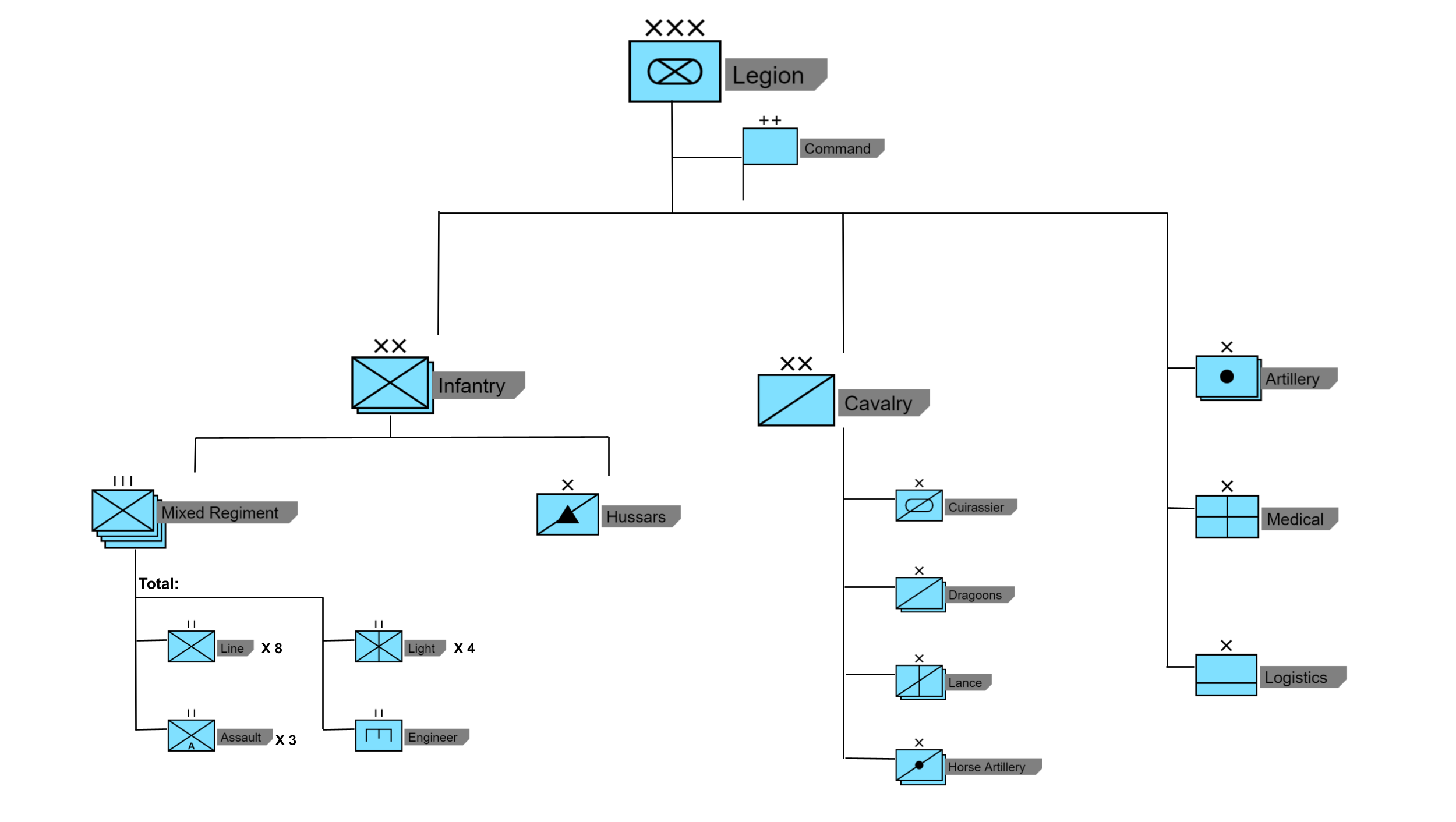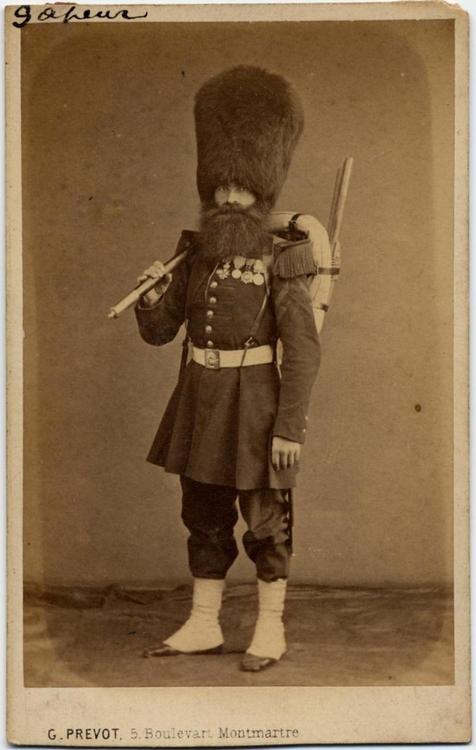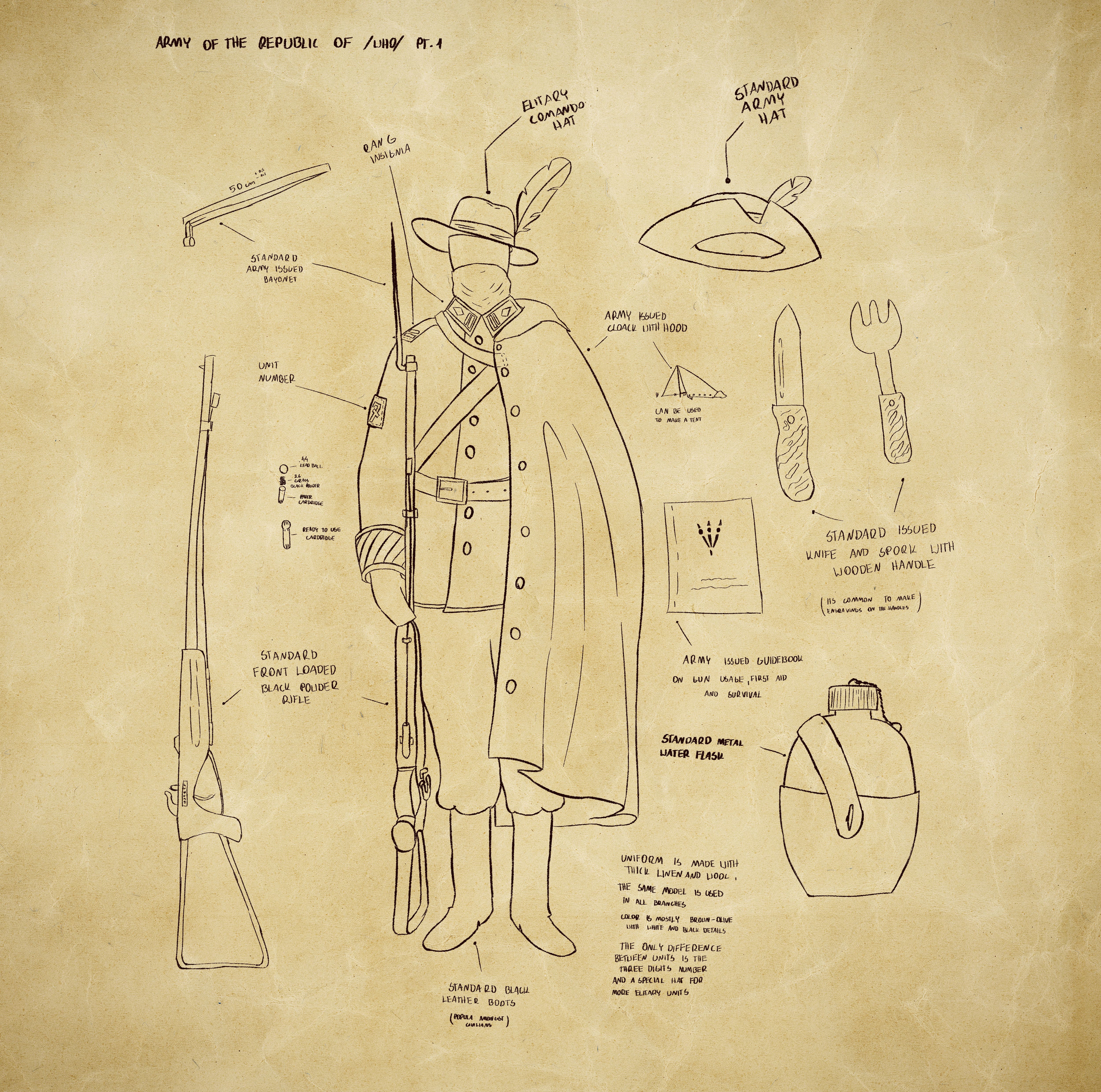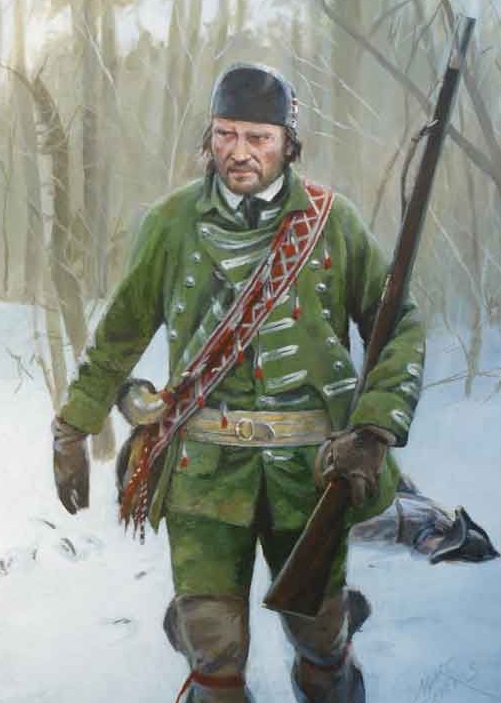The Republic's army
~70% finished, subject to changes & additions
Legions
The Legion is the Republic's largest administrative and operational unit. As of now, the Republic maintains 10 Legions. The Legions numbered I to X, comprised on average of around 25500 men per unit. This together with active reserves and any formations not included in the Legions, put the Republic's active army personnel number at around 280000. An impressive number even for a relatively large state.
Legions are comprised of 3 main branches: The Infantry, Artillery and Calvary.
A Legion's organization is oriented for a more defensive doctrine, though it is diverse in it's composition enough that enbles it to go on the offensive and adopt a mobile tactic.
Militias
The republic has a large reserve population of around 8 times that of the active army. Pick out a 100 male citizens on the streets, at least 10 of them would be active personnel or had some training. In order to maintain the reservists' combat readiness, local military districts maintain militia units and recruit any interested reserve personnel. The militias practice training exercises semi-regularly and participate in large scale exercises with their local Legion yearly. Most importantly, aside from being a pool of potential soldiers to replenish casualties, militias play a crucial role in defending the republic. In case of an invasion, militias not in the standing army would destroy major roads and bridges in order to impede the enemy advance. Militias are also expected to put up resistance to harass any occupying force using their familiarity with the local terrain.
Aside from military functions, the militias also provide public services. Militiamen aid the construction and maintenance of public infrastructure. Being stationed near communities, militias are often the first to respond to any natural disaster and lead the rescue effort before the army can provide more comprehensive relief. In more rural areas, the militia even acts as the de facto police.
Organization
- Command:
Infantry
- 2 Division
- 8 Regiments
- 32 Battalions total (Bnt.)
- Light Bnt.: 5 Company(Co.)(~ 80 men each), all skimishers (~8-10 per Legion)
- Foot Bnt.: 3 Line Co.(~120 men each)., 1 Grenadier Co(~140 men each)., 1 Light Co. (~14-16 per Legion)
- Assault Bnt.: 2 Line Co., 2 Grenadier Co., 1 Sapper Co.(~100 men each) (~5-8 per Legion, ~half)
- Engineering Bnt.: 2 Sapper Co., 2 Miner Co.(~80 men each) (~2-3 per Legion)
- 32 Battalions total (Bnt.)
- 8 Regiments
- 2 Attached Hussar (Light Cav.) Brigade:
- 6 Squadron(Sqdn.)
- 12 Troop(Tp., ~60 men & horses)
Artillery
- 2 Brigades
-
18 batteries total (Bty.)
Regimental Support Bty.: (~8)- 7 Field art. per Bty. (~20 person team for each artillery piece)
- 3 8-Pounder; 4 12-Pounder
Position/Support Bty.: (~10)
- 3 Field art. 5 Howitzers per Bty.
- 3 12-Pounder; 5 7-inch howitzer
- 7 Field art. per Bty. (~20 person team for each artillery piece)
-
- 2 Pontooneer Company(~180 men each)
Calvary
- 1 Brigade Cuirassier(Heavy Cav.): - 2 Sqdn. - 4 Tp.(~80 men & horses each)
- 2 Brigade Dragoon: - 4 Sqdn. - 8 Tp.(~80 men & horses each)
- 2 Brigade Lancers(Light Cav.): - 4 Sqdn. - 6 Tp.( ~90 men & horses each)
- 2 Brigade Horse Drawn Art.: - 8 Batteries - 6 Art. pieces per Bty. (~16 person team for each artillery piece)
Support Brigades
- ~ total 3000 men
- 1 Medical Brigade
- 1 Logistical/Support Brigade
Total: ~26000 ppl per Legion

Troop types of the Republic
Infantry
Light Infantry/Venators
Anything but light, these are the Republic's heavy hitters. Mostly drawn from hunters or motivated conscripts with keen eyes, they punch above their weight. Trained in small unit tactics, motivated and extremely resourceful, these men are the elites and pride of the Republic. From experience learnt during the Republic's founding war, Light Infantries are terrifyingly effective at softening advancing enemy formations and picking off commanders, making them easier to route when flanked by calvary, a hail of fire from line troops or a bayonet charge.
Derived from their custom of carrying a short sword when hunting, they are commonly armed with a ~30 inch long, single edge sword bayonet called a Gladius. As attaching a bayonet to the standard issue rifle decreases the accuracy of musket balls, in addtion to being cumbersome and unwieldy, the Gladius is almost exclusively used as a self defense weapon. Even for all their training and quick wit, a squad of Venators are vulnerable to enemy cavalry. As such, they rarely stand and fight. Rather, they retreat and fire, falling back to the safety of fortifications, leading the enemy to traps or a prepared battle line.

The Venators dress in a rather peculiar fashion compared to the line infantry or even other troop types of comparable role in other states. Forgoing standardized uniforms across regiments, they dress according to the season and terrain of the region they are posted in. This means their uniform can range from white, grey or even a spotted green. But the mostly hilly and forested landscape of the republic means that the most iconic color for the Venators remains a muted shade of green.
The emblem of the Venators is an Eagle owl, one of the forms usually taken by the nameless one as told in the Republic's scriptures.

Line Infantry/Pedites
The bread of butter of any country practice mass fire tactics. Over half of the Republic's army are of this type, as such, citizens simply refer to them as Legionaries. Mostly consists of conscripts, the Republic's line infantry is still nothing to scoff at. The martial tradition of the Republic and material reward encourage conscripts to perform well in battle. Even with a numerous and highly skilled skirmisher force, battles are still ended by exchange of line fire and bayonet charges. As such, even though the Republic's doctrine calls for defensive warfare, holding key forts, traffic networks and installations, the Pedites are still drilled for open combat.
Armed with the standard issue rifle musket, the Pedites are instructed to have their bayonet off unless when marching or in a pitched, open battle in order to increase the reload time and accuracy of their rifles.
The unusual color scheme of brown and olive give them some concealment during battle. But in order for ease of commanding and communication, their hats are decorated with colorful feathers.
The emblem of the Pedites is a Barn Owl, also another form usually taken by the nameless one.
Grenadiers/Palatini
Experts in siege/counter-siege tactics, they are what holds the line together. Drawn from conscripts with the strongest physique, they are stoic, tough and intimidating. To be selected as a Grenadier is an honour for the conscripted. More drilled and experienced than Pedites, they rarely break and route.
The Palatini wears a light half cuirass only covering the front chest. Well trained in hand-to-hand combat, they are placed at key points at forts, either to hold off attackers or on the rare occasion, storming them. Their armor, size(both numbers and body) and training make them excellent shock troops. A well timed Palatini charge is sometimes enough to break an entire battalion of less trained soldiers.
Although the effectiveness and safety(espically that of friendly fire & accidental discharge) grenades have came under question by senior officers and politicians alike, the Palatini are still armed with them, raining death on anyone unfortunate enough to face them in a siege.
Their Emblem bird is a Great Horned Owl.

The Kit of a Republican Soldier

Engineering troops:
The Republic values their engineers greatly. So much in fact, that two academies of military engineering exist in the Republic. The Military Engineer Division's Emblem bird is a Burrowing Owl.
Pioneering sappers
Due to the Republic's fondness for siege tactics, sappers attached to the regimental level provide the Republic both a defensive and offensive edge.
Drawn from mineral miners, educated factory workers and woodworkers, they are trained in basic military engineering. When setting the battlefield, sappers handle the more complex fortification work while Pedites and Palatini, more numerous, help with the labour intensive work of chopping down trees and digging trenches.
Sappers often accompany Venators to set up obstacles and traps like the Cheval de frise in forward positions to support the skirmishers or destroy enemy obstacles/fortifications ahead of the main army. Trained in siege tactics, they work together with the Palatini to halt the enemy with grenades and traps or storm fortified enemy positions.
Miner
Only the most daring and shrewd can become miners in the Legion. Drawn from experienced mineral miners & qualified volunteers, they prepare more complex traps, especially the explosive kind for the enemy. In turn, they are also experts at disarming enemy traps.
Having access to better tools and resources, they can build more complex field fortifications than sappers.
Most of the time, they stay behind with the Pontoneers.
Pontoneers
Pontoneers are perhaps the most educated and qualified soldiers in the Legion. They stay behind the army and usually only move with the artillery. With access to the heaviest tools, they can create semi-permanent fortifications such as wooden forts and Schanze. And of course, as the name implies, they can build pontoon bridges to facilitate marching across rivers. One company is attached to each artillery brigade(~180 men)
Cavalry
Due to a lack of pasture land for horses(most are dedicated to food production), defensive doctrine and the hilly terrain, the Republic puts less emphasis on their Cavalry compared to many militaries of the world. But the Republic's military still values the speed and shock value of them.
If the Infantry is the best place for the common joe to earn fame and glory. The Cavalry Corp is where the more well off citizens earn them. Despite a lack of riding tradition, the Cavalry is where most sons of upper middle class families end up, perhaps due to both foreign influence and the sheer expenditure associated with learning how to ride. Although the military has tried different methods to encourage poorer citizens to join, this branch of the Army remains a kind of rich kids' club.
As this is also where a large portion of educated service members belong. To become an officers, one has to complete his mandatory service, meet the education requirment and purchase a commission. While the republic provides subsities to potential officiers who earned some kind of battle honor, enough to pay for a commission fee that's significantly lower than other militaries, around 60% of commisoned officers still started off as a rider.
Cuirassiers/Cataphracti
THE best equipped troop type of the Republic. Armored and well trained, they rival the Venators as the poster boys of the Republic's army. Though the Republic possess way fewer heavy cavalry than other militaries of similar technology level, their equipment is one of the best in the world. Heavier and more protective than the body armor of the Palatini, the Cuirass worn by the Cataphracti gives them more mass and protection when charging into an enemy unit. If the Palatini are hammers that break the enemy line, Cataphracti are battering rams, able to break even the toughest of companies.
While infantries usually charge towards the weakest link of the enemy, the armored Cataphracti deliberatly charge and attempt to break the strongest enemy units. If the timed correctly, such a pincer maneuver could route entire armies.
Armed with pistols, carbines or even miniature hand mortars, their main weapon remains their Calvary Spatha. Over a meter long and built for thrusting, the straight sword spears through less armoured riders and infantry with ease.

Dragoons
Dragoons are the amphibious animal of the army. Able to fight dismounted, they provide mobile firepower to the army. With sharpshooting skills rivalling that of the Venators, they pick off enemy soldiers with their carbine from a safe distance and scurry away before the enemy can return fire. But they are still trained with the cavalry sword taking the role of medium cavalry, utilizing charges to break the line or reinforce any allied horsemen locked in mounted melee combat.
Hussars
Daring light cavalry trained in reconnaissance and horseback sword fighting. Equipped with sabres and carbines, they are the eyes and ears of the army, riding ahead of the Venators and giving warnings to enemy movements using their carried signal flares. Their excellent sword fighting skills also make them great anti-cavalry units. Despite their "light" classification, they are often tasked to chase down and assassinate enemy commanders on horseback. Their forward deployed nature also makes them great companions to the Venators, covering them from any calvary attempting to harass the sharpshooters.
Lancers:
Like more traditional shock cavalry, the lancers' only job is to break infantry. Though they can also be used in an anti-cavalry role, although they are less effective when faced with armored foes. Due to a relative lack of riding tradition in the Republic, a portion of Lancers are actually recruited from aboard. Though they may fight with less fanatical enthusiasm as the Republic's citizens, their proficiency with a lance speaks louder than words.
Artillery
Being an artillery army, the Republic invests heavily in its gunners. Standardised systems ensure the quality of guns and ammunition and eased supply difficulties. The Republic's gunners practice precise gunnery with their advanced sights or indirect fire with accurate maps and calculation tools. While the regimental batteries attached to infantries and support batteries prefer firing their guns behind earthworks, horse artillery keeps up with the cavalry core and supports them. Men in horse batteries are trained to set up and fire their guns with lighting fast efficiency and discipline and soften the enemy before the cavalry charges.
The standard field guns are 6, 8 and 12 pounders with calibres of 3.8 in., 4 in. and 4.8 in. respectively. While howitzers are standardized at 7 in..While on the move, each field gun is allocated with around 300 rounds per gun and howitzers 195 rounds per gun.
8 pounders and 12 pounders are the main guns of the Legions, mostly firing shrapnel shells from emplacements, with balls and canisters only used when the situation calls. Howitzers fire shells exclusively, decimating any approaching columns. 6 pounders are only used by the horse artillery batteries due to their lightweight and due to their ability to catch the enemy by surprise, ball and canister shots are preferred.
Depending on the context and availability, Coehorn mortars are carried and used by the Artillery brigades as well. Usually used to defend encampments and sustain sieges before the siege guns have arrived.
The guns emplaced in fortresses start at 12 pounds, 18 pounds and then 24 pounds. While mortars are 10 and 13 inch. These guns are usually manned by militia units but when under siege, Legionary gunners would take over command of some guns especially when they are not able to deploy their field pieces.
The Republic's superior steel and iron foundries allow its artillery to be light and resilient. The precise machining and gunnery of individuals allow these smoothbore guns to achieve terrifying accuracy even over long distances. Wishing to maintain its artillery advantage, military engineers and academies have proposed different improvements, including the addition of rifling to new types of guns, new shell types shaped like a bottle and even a breech-loading system. Though the military sees the new rifled guns and bottle-like shells as more promising.
Auxillary Units
Currently the military of the Republic has a powerful and well trained army, however, there is a need for more specialized units for such situations where the armed forces might be having issues, for this the creation of 2 military organizations was done.
The Ranger Corps are light infantry troops designed for fighting in heavy terrain, long range reconnaissance, and experimental weaponry testing. Rangers excel in raids, ambushes, scouting, quick manouvers, and cross country ranging, in war time they participate and assist the military in their operations. During peacetime they are active in the frontiers and act as border guards by manning observation posts and doing patrols. Rangers are able to go off from the border into the lands of the druids, the starship, and the monks with free reign due to the lack of state presence there in large sections of their lands, on the southern border with Hoshiyomia the rangers mainly travel along the border and don't cross into their territory without official approval. There are a multitude of well hidden supply depots that the rangers use for their guard duties, and due to their guard status and relative freedom of movement, the Rangers also squash any bandits or schizos and investigate any unusual disturbances in their area.
The Rangers are mainly recruited from hunters, axemen, farmers, and postal workers in particular, any potential volunteers to the army that may show enough promise for recruiters are noted and considered for Ranger training. These troops will then go through various training regimes designed to acclimate them to harsh terrain and weather conditions. The Rangers are also trained to some degree in horsemanship to aid their reconnaissance or raiding missions.
On the higher level Rangers are organized into regiments, which are subordinated to the Ranger Corps. Battalions within these regiments operate out of towns that are near supply depots or small military installations in the hinterlands of the Republic, and the companies usually no more than 60 men take over observation posts. The Rangers are of course expected to participate in open battle too when they are not assigned for reconnaissance duty. On the field, they operate in the same role as other light infantries. These light troops are however not expected to directly participate in sieges. Instead they use their maneuverability to harass their foes, attacking baggage trains and feeding intelligence to their superiors. When a Legion mobilizes for war. In the 3rd Schizo Incursion, a battalion of rangers successfully raided a small town 60 miles away from the front, which served as a supply hub of the invaders. The raid successfully destroyed a large number of provisions that delayed the assault on the Fortress near Trenton, which gave the V Legion enough time to mobilize and reinforce the front. The Rangers are also expected to participate in partisan warfare when ordered or cut off from the chain of command. The 8th Battalion is famous for taking out many Schzio Shamans during the Eastern Campaigns. There are 4 ranger regiments active.
I RANGER is headquartered near the capital, serving both as a training reserve and administrative head, this regiment is also used for experimental weaponry testing.
II RANGER is stationed near the eastern frontier.
III RANGER is stationed in the northern frontier.
IV RANGER is a 'nomad regiment' and has relative freedom of movement in the republic, they are tasked with assisting the standard military and the militias around and are available for quick deployments.
The Ranger Corps is directly subordinate to the Commander of the Armed Forces.
Their motto is "Hope for the best, prepare for the worst"

The Trawler Corps are units that are designed for amphibious operations on the coasts of the Republic. They are specialized for quick deployment and light arms, and undergo training alongside the navy for fighting landings, opening beach heads, and the taking of ports. As a result of this training and preparation they are a highly adaptable force and carry great logistical flexibility. One of the reason for their inception is the Islands north of the Penisular. The Navy was concerned about the need to defend and most importantly take back the Fortifications in case of an naval invasion that overwhlemed the Republic. Another part of their existence was in thanks to the Hoshiyomi Navy's assistance, who suggested the creation of an flexible amphibious force aside from the Marines, while the original name of this force was 'Maritime Light Foot Regiment' it eventually changed to The Trawler Corps due to the large amount of recruits being fishermen teams that operated in such boats. They, along with the Navy and their Marines, often participate in exercises with the Hoshiyomian forces. As such they have gained an invalueble amount of experience, which they put to use in various smaller engagements in the past, and would continue to do so in the future. They also serve as extra man that gaurd coastal installations and respond to any anamolies near their station.
There are 2 active Regiments that participate in multiple duties around the Coast. The units are also curiously mixed like a Legion despite their small size. Specialized and retrained engineers from the Engineer Corps would prepare bridges and pulleys to do rapid unloading onto land. There are large amounts of line infantry with smaller teams of light infantry to support them. Artillery is light and oftenly mixed with mortars and howitzers as the navy is generally expected to support them with naval bombardments but they do have access to heavier pieces. For the cavalry they eschew the light hussars, opting for dragoons to support them on the field or act as advanced scouts dur to their ability to fight dismounted when needed. This unique unit is trained to quickly deploy and land using smaller sailing boats and ships, then advance under the support of artillery (naval or otherwise) to their objective. They are assisted by ship board marines or any regular army units as the situation and their commanders dictate.
1st TRAWLER is stationed in the port city of the Republic and have their training grounds further north.
2nd TRAWLER is stationed in the northern port city and are also given tasks of experimental weaponry testing.
These regiments are organized under the Trawler Corps, which are directly subordinated to the Republican Admiralty.
Their motto is "Atlantis won't conquer itself"